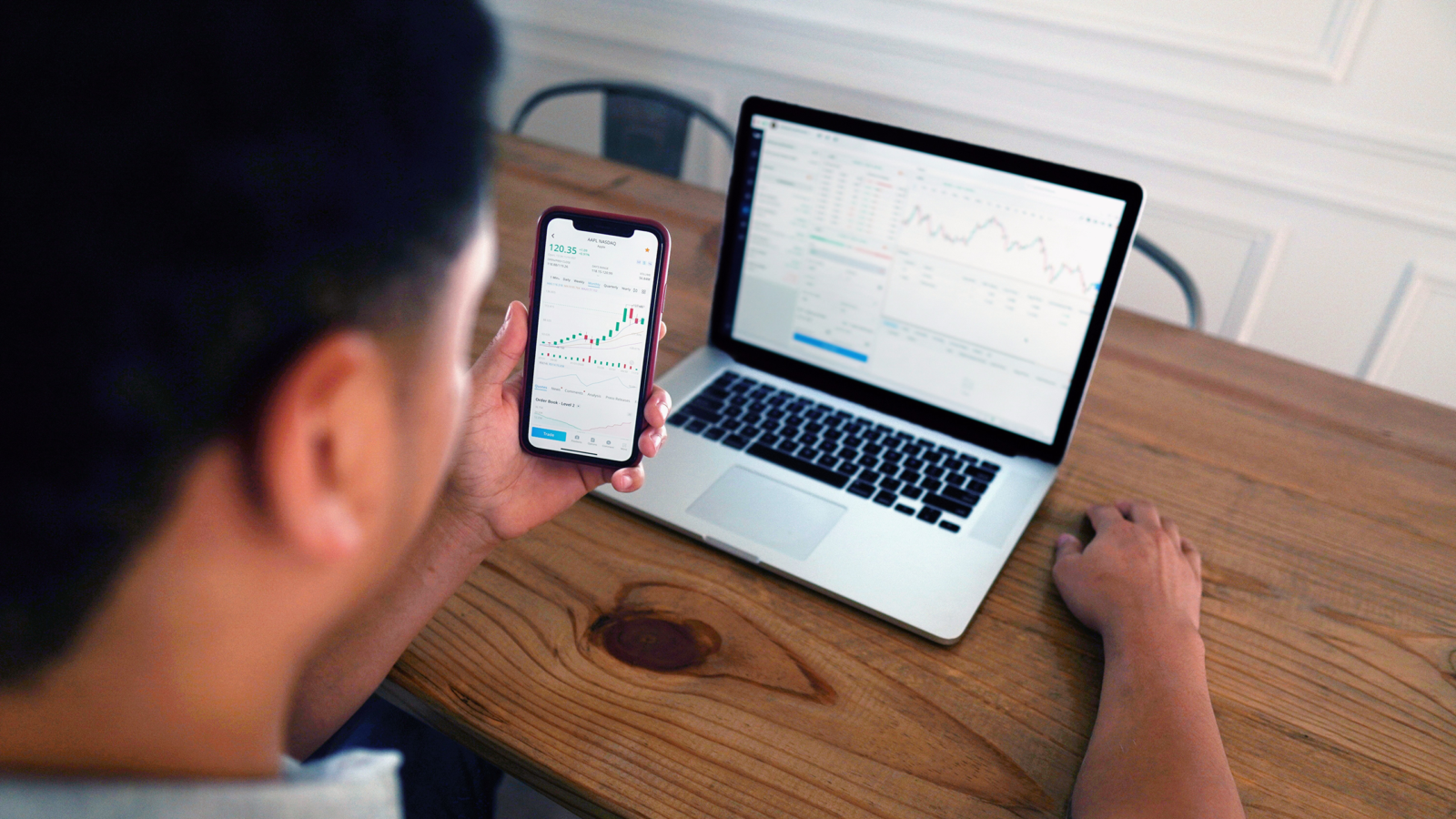Good morning.
Turns out the tariff sheriff’s gun was fully loaded.
Wednesday’s 4 p.m. Rose Garden “Liberation Day” tariff announcement came just as markets had closed for the day — but after-hours trading reeled from the impact. The SPDR S&P 500 ETF Trust (a.k.a., the SPY ETF that tracks the namesake index) is down roughly 3.3% in pre-market trading this morning, while the Nasdaq 100 Index-tracking Invesco QQQ ETF is down 3.8% and the SPDR Dow Jones Industrial Average ETF Trust is down 2.8%.
The reaction underscores how far beyond traders’ expectations the White House went with the tariffs. The European Union, for instance, was slapped with a 20% levy, while the effective rate on Chinese goods will now be around 54% — all after many traders were pricing in just a 10% universal tariff on all imports. If this is a spaghetti Western, Wall Street wants an intermission before Act II.
E Pluribus Unum: Individual Investors Become Market-Moving Force

The 60/40 split is taking on a new meaning in the world of finance.
Numbers long associated with the conventional wisdom of splitting investment portfolios between stocks and bonds now apply to the split between individual investors and institutional players. According to a recent JPMorgan analysis, individual investors now account for 60% of US equities, an all-time high. And just in time for a crash course in tumultuous, tariff-tinged investing — in which they’re making their presence felt.
Letter to the Editor
As the market nosedived this year, the individual investors used the opportunity to “buy the dip,” pouring a remarkable $67 billion into US equities and ETFs in the first-quarter, per VandaTrack data — or down just barely from the white-hot, optimistic final quarter of 2024. They’re braking harder now: In the two weeks leading up to March 18, Barclays data showed that retail outflows from US equities reached $4 billion, signalling a last-minute U-turn from buy-the-dip-mania at the start of the market rout. “This does appear to be a bit of a reactionary trading activity,” Rob Austin, director of research at Alight Solutions, told CNBC.
In fact, it’s this type of reactionary retail trading that is now significantly shaping the market, JPMorgan analysts wrote in a recent note to clients: “The higher the appetite by US households to hold equities in their portfolios, the more expensive the equity market becomes and vice versa.” US households on average held 42% of their assets in US equities in the first quarter, JPMorgan found, down just slightly from a record 43.5% in Q4 2024.
The market-shaping retail investment boom has, in part, been driven by platforms like Robinhood. And, if some major players have their way, the “democratizing of finance” movement will soon extend beyond mere equities:
- In his annual shareholder letter to investors published earlier this week, BlackRock CEO Larry Fink said the investment giant is on a mission to open up retail access to private markets, such as “data centers, ports, power grids, the world’s fastest-growing private companies.”
- “Assets that will define the future… [are] in private markets, locked behind high walls, with gates that open only for the wealthiest or largest market participants,” Fink wrote.
Goldman Gatekeepers: Not-so-coincidentally, BlackRock is already expanding access to said private markets. Last week, the investment giant rolled out a new program to offer more complex private equity and credit funds to its wealth management clients. Meanwhile, on Wednesday, Goldman Sachs similarly expanded its private equity offerings to individual clients with at least $5 million in their portfolios, according to a Bloomberg report. If Wall Street really wants to open private investing to individual investors, it seems like the rich will be the first guinea pigs in the trial.
An Unlikely Trio Of Rap, Rock, And Baseball

Rapper Too $hort, and rock-and-roll frontman Billie Joe Armstrong (Green Day) are both Oakland legends. But they have another thing in common: investing in the Oakland Ballers.
And they’re not alone — 2,200+ others have invested in this budding baseball team with a unique fan-ownership model.
In a world where sports owners have failed to put fans first, the Ballers are responding with a team by and for their city.
It’s part of an even bigger movement towards community-driven sports. With $1M+ in merchandise sold in their first season and a market of 7.8 million potential fans, they have an opportunity to make history in sports culture.
Learn how you can join the Baller’s fan-investor community here.*
Apple Card Plays ‘Spin the Bottle’ With Finance Giants
The biggest names in payments are jockeying for a bite of the Apple.
Earlier this week, The Wall Street Journal reported that Visa offered $100 million to convince the tech giant to drop Mastercard as the network of choice for its credit card, which has some 12 million users. Mastercard and American Express are said to be mounting rival campaigns — but the drama goes well beyond the jousting of payments providers.
Culture Shock to the Core
This whole juicy affair comes on the heels of an effective disaster for Goldman Sachs.
The bank made what was advertised as a “game-changing” move in 2019, signing up as the banking partner on Apple’s credit card when it launched. But then came the realization that — at their core — these partners were very different operators.
In its consumer-focused tech mindset, Apple pressed for almost all card applicants to be approved. Of course, that’s not how sober banks like Goldman work, and the Wall Street titan ended up saddled with loan losses — at one point in 2022, Goldman’s loss rate on credit card loans was the worst among all American issuers, worse at 2.93% than even subprime lenders. Goldman lost hundreds of millions on the deal, according to analyst estimates, and has been in talks for an exit since 2023. That’s the backdrop of Visa’s current opportunity:
- While the Apple Card was bad business for Goldman, the tech company makes money off the product by offering rewards and incentives to its most ardent brand enthusiasts to spend in the Apple store. The card’s network provider, of course, gets a cut of transactions and could play a role in the future of Apple’s increasingly massive payments ecosystem, hence the appeal to Visa, Mastercard and Amex.
- Meanwhile, JPMorgan, Capital One, Synchrony Financial, and a handful of other banks — all with more experience serving Main Street than the investment-focused Goldman — have made inquiries about taking over the program, which has about $20 billion in balances.
Car(d) Troubles: For Goldman, the fiasco was a big spur for its return to basics. Last year, the bank announced it was taking a $400 million pre-tax hit in the third quarter as it worked to unwind a series of ambitious consumer initiatives whose produce looked less like the golden apples of Greek myth than fruit suffering a bad case of frostbite. One of those initiatives was another branded credit card, this one with automaker GM: Goldman will officially hand that program off to Barclays this summer. While the consumer retreat meant some sting, Goldman ultimately reasserted its financial world muscle: Goldman’s equity trading business made a record $13.4 billion in net revenue last year. The obvious lesson: Stick to your knitting, especially if your knitting is rich people, who generally don’t knit.
Smarter ETF Strategies Start Here. The ETF market moves fast — ETF Upside helps you stay ahead. Get expert analysis, strategy insights, and key developments delivered free to your inbox each week. Whether you’re an advisor or investor, it’s your edge in a shifting landscape. Subscribe for free today!
Circle Plans IPO as Stablecoins Flex Market Muscle
Circle is living up to its name: After scrapping its SPAC plans three years ago, the stablecoin issuer completed a 360-degree turn and filed for an IPO yesterday. Circle could reportedly debut on the NYSE as soon as next month and is eyeing a valuation of up to $5 billion — a $4 billion drop from its SPAC era. Still, it’d be the crypto industry’s largest IPO since Coinbase went public in 2021.
Circle said its SPAC attempt “simply termed out” after multiple extensions, but the Financial Times reported the SEC didn’t approve the deal. Following POTUS’ pro-crypto overhaul of the SEC, Circle could get a warmer welcome this time around.
Around and Around
Circle’s stablecoin, USDC, which like many stablecoins is pegged to the US dollar, is the second-largest stablecoin behind Tether, with roughly $60 billion worth in circulation.
- While Tether dominates stablecoins with 67% market share, USDC is gaining ground fast: Its market cap surged 36% this year, while Tether gained 5%.
- Coinbase, which has a deal to pocket half of USDC’s revenue, said it plans to push the stablecoin into the No. 1 spot.
The stablecoin market expanded nearly 50% last year and has gained more than 10% so far this year as investors pile into the digital asset. Though stablecoins are generally perceived to be less volatile than other cryptocurrencies (especially memecoins), they could still carry risk.
USDC depegged from the US dollar in 2023, temporarily trading below 87 cents, following the collapse of Silicon Valley Bank. Coinbase paused redemptions of USDC after traders cashed out $1.6 billion worth.
The year before, stablecoins’ rep was hurt when TerraUSD dramatically depegged from the US dollar, losing virtually all of its value. But while USDC depegged because a chunk of its reserves was tied up at Silicon Valley Bank, TerraUSD wasn’t backed by real-world assets.
The Gateway Crypto: The crypto industry is setting stablecoins up as the safer, more reliable alternative to traditional cryptos. Financial institutions are on board, with JPMorgan Chase and Citigroup underwriting Circle’s IPO. So is Washington: A bill regulating stablecoins was approved by a Senate committee last month, and a House committee is expected to vote on parallel legislation today. If stablecoins can live up to their name, they could have a halo effect on the wider crypto industry.
Extra Upside
- Power Outage: Tesla and Rivian both reported dramatic declines in sales of their electric vehicles in the first quarter of 2025 — meanwhile, Tesla CEO Elon Musk may be stepping back from some of his White House responsibilities in the coming weeks.
- Tick-Tock, TikTok: Amazon is among the high profile bidders for TikTok as the social media platform faces an April 5 ban in the U.S. — the White House is also reportedly considering allowing a joint venture that would be 50% held by American investors.
- Volatility Is Opportunity — If You’re Prepared. Learn how to spot key trade opportunities before big moves happen — so you can trade with clarity, not guesswork. Discover the strategies smart traders use to stay ahead.**
** Partner
Just For Fun
Disclaimer
*This is a paid advertisement for the Oakland Ballers’ Regulation CF offering. Please read the offering circular at https://invest.oaklandballers.com/.

